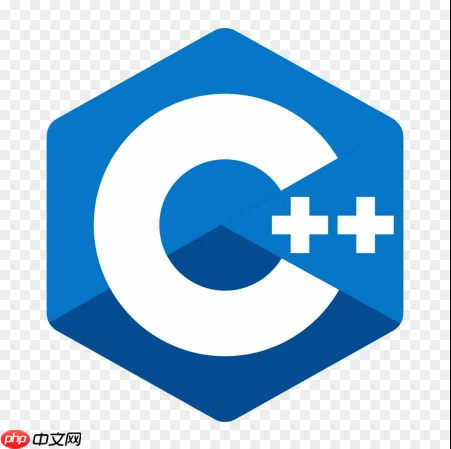c++++中利用指针进行数组去重的核心在于通过双指针实现原地修改和高效遍历。1. 使用 slow 和 fast 两个指针,slow 指向去重后的末尾,fast 遍历数组;2. 当 fast 指向的元素与 slow 不同时,将其复制到 slow+1 的位置并移动 slow;3. 对于未排序数组,可先排序再用双指针,或使用哈希表记录已出现元素以实现 o(n) 时间复杂度;4. 可借助 std::unique 和 std::erase 实现简洁但效率较低的去重方法;5. 对象或结构体数组需重载 == 运算符或提供自定义比较函数;6. 原地操作虽节省内存但会修改原始数组,必要时应创建副本或采用替代方案如哈希表、外部排序。

C++中利用指针进行数组去重的核心在于,通过指针操作实现高效的遍历和原地修改,避免额外的内存开销。双指针算法是关键,一个指针用于遍历数组,另一个指针指向去重后的数组的末尾。

解决方案
核心思路是使用两个指针:
slow
fast
fast
slow
fast
slow
fast
slow + 1
slow
立即学习“C++免费学习笔记(深入)”;

以下是一个示例代码:
#include <iostream>
#include <algorithm>
int* removeDuplicates(int* arr, int size) {
if (size == 0) {
return arr; // 空数组,无需去重
}
int* slow = arr;
int* fast = arr + 1;
while (fast < arr + size) {
if (*fast != *slow) {
*(++slow) = *fast; // 先移动 slow 指针,再赋值
}
++fast;
}
return arr; // 返回原始数组的指针,但数组已被修改
}
int main() {
int arr[] = {1, 1, 2, 2, 3, 4, 4, 5};
int size = sizeof(arr) / sizeof(arr[0]);
removeDuplicates(arr, size);
// 输出去重后的数组(实际长度需要单独计算)
for (int i = 0; i < size; ++i) {
std::cout << arr[i] << " ";
}
std::cout << std::endl;
// 计算去重后的数组的实际长度
int* last = arr;
while(*(last+1) != 5 && last < arr + size - 1){
last++;
}
std::cout << "去重后的数组长度: " << last - arr + 1 << std::endl;
return 0;
}这段代码直接修改了原始数组。注意,虽然数组的内容被修改了,但数组的大小并没有改变。你需要单独记录去重后数组的实际长度,例如通过计算
slow

如果数组未排序,一种方法是先对其进行排序,然后再使用双指针算法。排序可以使用
std::sort
std::unordered_set
#include <iostream>
#include <algorithm>
#include <unordered_set>
int removeDuplicatesUnsorted(int* arr, int size) {
if (size == 0) {
return 0;
}
std::unordered_set<int> seen;
int j = 0;
for (int i = 0; i < size; ++i) {
if (seen.find(arr[i]) == seen.end()) {
seen.insert(arr[i]);
arr[j++] = arr[i];
}
}
return j; // 返回去重后的数组长度
}
int main() {
int arr[] = {5, 2, 1, 2, 3, 4, 1, 5};
int size = sizeof(arr) / sizeof(arr[0]);
int newSize = removeDuplicatesUnsorted(arr, size);
// 输出去重后的数组
for (int i = 0; i < newSize; ++i) {
std::cout << arr[i] << " ";
}
std::cout << std::endl;
std::cout << "去重后的数组长度: " << newSize << std::endl;
return 0;
}std::unique
std::erase
C++ 标准库提供了
std::unique
std::erase
#include <iostream>
#include <algorithm>
#include <vector>
int main() {
std::vector<int> arr = {1, 1, 2, 2, 3, 4, 4, 5};
// 使用 std::unique 将重复元素移动到末尾
auto it = std::unique(arr.begin(), arr.end());
// 使用 std::erase 删除重复元素
arr.erase(it, arr.end());
// 输出去重后的数组
for (int i = 0; i < arr.size(); ++i) {
std::cout << arr[i] << " ";
}
std::cout << std::endl;
std::cout << "去重后的数组长度: " << arr.size() << std::endl;
return 0;
}std::unique
std::vector
std::vector
如果数组包含的是对象或结构体,你需要定义一个比较函数,用于判断两个对象是否相等。然后,可以将这个比较函数传递给
std::unique
==
例如:
#include <iostream>
#include <algorithm>
#include <vector>
struct Point {
int x;
int y;
bool operator==(const Point& other) const {
return x == other.x && y == other.y;
}
};
int main() {
std::vector<Point> arr = {{1, 2}, {1, 2}, {3, 4}, {5, 6}, {5, 6}};
auto it = std::unique(arr.begin(), arr.end());
arr.erase(it, arr.end());
for (const auto& p : arr) {
std::cout << "(" << p.x << ", " << p.y << ") ";
}
std::cout << std::endl;
std::cout << "去重后的数组长度: " << arr.size() << std::endl;
return 0;
}如果对象或结构体没有重载
==
std::unique
#include <iostream>
#include <algorithm>
#include <vector>
struct Point {
int x;
int y;
};
bool comparePoints(const Point& a, const Point& b) {
return a.x == b.x && a.y == b.y;
}
int main() {
std::vector<Point> arr = {{1, 2}, {1, 2}, {3, 4}, {5, 6}, {5, 6}};
auto it = std::unique(arr.begin(), arr.end(), comparePoints);
arr.erase(it, arr.end());
for (const auto& p : arr) {
std::cout << "(" << p.x << ", " << p.y << ") ";
}
std::cout << std::endl;
std::cout << "去重后的数组长度: " << arr.size() << std::endl;
return 0;
}原地操作虽然节省了内存,但它直接修改了原始数组,这在某些情况下可能不合适。如果需要保留原始数组,可以先创建一个副本,然后在副本上进行去重操作。此外,如果数组非常大,原地操作可能会导致性能问题,因为需要频繁地移动元素。在这种情况下,可以考虑使用其他算法,例如哈希表,或者使用外部排序。
以上就是C++中如何用指针实现数组去重 双指针算法与原地操作技巧的详细内容,更多请关注php中文网其它相关文章!

每个人都需要一台速度更快、更稳定的 PC。随着时间的推移,垃圾文件、旧注册表数据和不必要的后台进程会占用资源并降低性能。幸运的是,许多工具可以让 Windows 保持平稳运行。

Copyright 2014-2025 https://www.php.cn/ All Rights Reserved | php.cn | 湘ICP备2023035733号